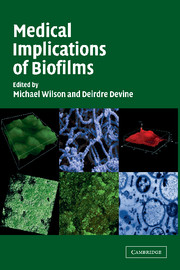Book contents
- Frontmatter
- Contents
- Preface
- List of Contributors
- PART ONE INTRODUCTORY CHAPTERS
- PART TWO BIOFILMS ON PROSTHETIC DEVICES
- PART THREE ORAL BIOFILMS
- 8 Novel Microscopic Methods to Study the Structure and Metabolism of Oral Biofilms
- 9 Oral Streptococcal Genes That Encode Biofilm Formation
- 10 Gene Expression in Oral Biofilms
- PART FOUR BIOFILMS ON SHEDDING SURFACES
- Index
- References
8 - Novel Microscopic Methods to Study the Structure and Metabolism of Oral Biofilms
Published online by Cambridge University Press: 23 November 2009
- Frontmatter
- Contents
- Preface
- List of Contributors
- PART ONE INTRODUCTORY CHAPTERS
- PART TWO BIOFILMS ON PROSTHETIC DEVICES
- PART THREE ORAL BIOFILMS
- 8 Novel Microscopic Methods to Study the Structure and Metabolism of Oral Biofilms
- 9 Oral Streptococcal Genes That Encode Biofilm Formation
- 10 Gene Expression in Oral Biofilms
- PART FOUR BIOFILMS ON SHEDDING SURFACES
- Index
- References
Summary
INTRODUCTION
Uniquely in the human body, the tooth surface provides a non-shedding surface for microbial attachment. As a result, large numbers of microorganisms accumulate, together with their metabolic products, to form dental plaque, especially at occluded sites. Dental plaque was the first biofilm described by van Leeuwenhoek (1683), who noted the unusual resistance of the ‘animalcules’ he observed to treatment with vinegar (McHugh, 1999). Since this time, dental plaque has probably been the most studied of biofilms, with some justification: dental plaque is the most accessible of human-associated biofilms and is responsible for the most common diseases affecting man in the developed world – dental caries and periodontal diseases. This chapter provides a brief historical view of light and electron microscopic studies of dental plaque. The major focus of the chapter is then to describe how novel microscopic approaches are providing new insights into the structure and metabolic activities of dental plaque biofilms.
LIGHT AND ELECTRON MICROSCOPIC STUDIES OF DENTAL PLAQUE DEVELOPMENT
Since van Leewenhoek's time, vast numbers of light microscopic studies (especially of dental plaque) have examined the structure of biofilms. Furthermore, the development of electron microscopy (EM) began to unearth the diversity within, and structures of, developing dental plaque (Saxton, 1973; Listgarten, 1976, 1999).
The development of dental plaque can be divided into several arbitrary stages. Pellicle formation occurs almost instantaneously on a cleaned tooth surface (Figure 8.1a). After a cleaned tooth surface has been exposed for 4 hours to the oral environment, relatively few bacteria are found.
- Type
- Chapter
- Information
- Medical Implications of Biofilms , pp. 173 - 188Publisher: Cambridge University PressPrint publication year: 2003
References
- 1
- Cited by



